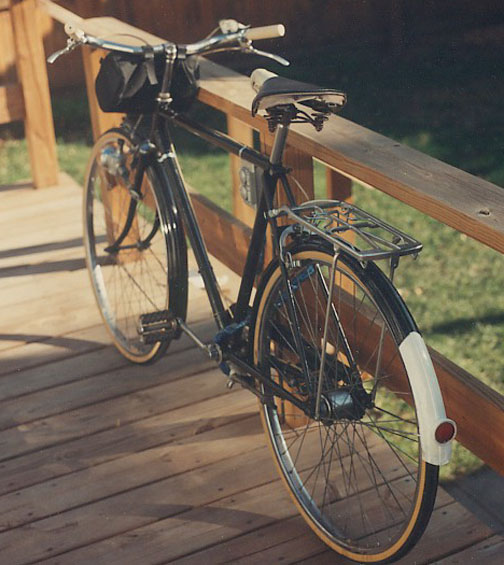
Made in Nottingham, England

Photo 1. 1968 Hercules roadster - restored condition - December 1988
21" frame with 26" wheels
Camera: Pentax 6x7
I favor this style of bicycle more than any other, primarily because of its tough, workmanlike appearance. At one time, I knew them collectively as "English Racers" but that may have been a misnomer, and had no basis in historical fact. It was probably just a convenient way to categorize all similar looking touring bikes produced in England from about the middle of the 20th century, up through about 1970 – give or take 10 years. Genuine English "racing" bikes (reference the Raleigh "Clubman") may be distinguished by the ram's horn (wrap-around) handlebars and lack of mud guards (fenders) to name but two features. Anyway, the roadster, or touring style bikes such as this 1968 Hercules were certainly, if nothing else, a familiar form of dependable, human-powered transportation for many years around the world.
Sometime around 1985, I saw this 1968 Hercules 3-speed roadster advertised in a local newspaper. The previous owner was a retired gent who took the time to license it through his town hall. The license sticker was still affixed to the rear fender when I got it. Initially, after purchasing it, I gave it a set of new John Bull rubber brake shoes, gum-wall tires, tire tubes, a lube job, a touch-up paint job, a generator head lamp (from my former circa 1974 Royce-Union 10-speed), and a Pletscher (Switzerland) "Modell C" luggage rack with a spring loaded parcel holder. The results of the refurbishment can be seen in the photo. It had 26" wheels, and a 21" frame, which was a bit small for me, but I still enjoyed riding it around the neighborhood (to the local pub) for a few years. To determine the frame size, I measured the seat tube length from the center of the bottom bracket to the middle of the top tube.I am still the "custodian" of this bike, but it needs to be detailed, and tuned up again. The bike was 17 years old when I bought it back in 1985, and has since aged another 33 years (as of 2018). Note that the luggage rack design was still available in 2006 but made in China rather than Switzerland. Also note the Cannondale "Toot" saddle bag on the front handlebars. Wish I had bought a few of them because they last forever (this one was still going strong in 2018) and the size and style was perfect for these old roadsters.
Made in Nottingham, England
More recently (September 19-21, 2006) I visited Philadelphia, Pennsylvania and noticed quite a few old bikes being ridden all over town. At one point, I asked a young lady who was locking her vintage bicycle to a municipal hitching post if she might know why there were so many old bicycles on the streets. She explained there was a shop on 9th street called, "Via" that handled sales and service of the old relics. Most of the bikes on the streets of Philadelphia were not as old as my 1950 Raleigh roadster, but rather, probably dated from 1965-1980, which was old enough to grab my attention. I was inclined to visit Via before leaving Philadelphia, but unfortunately, never made it until September 2011.
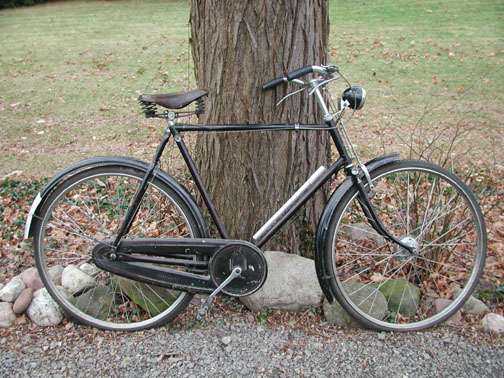
Photo 3. 1950 Raleigh roadster - original condition - December 2, 2006
A "Tourist Model 2" a.k.a. "DL-1"
24" frame with 28" wheels
Camera: Nikon Coolpix 990
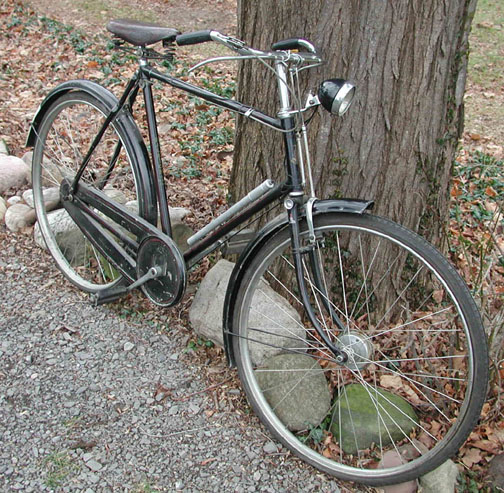
Photo 4. The day it was rescued
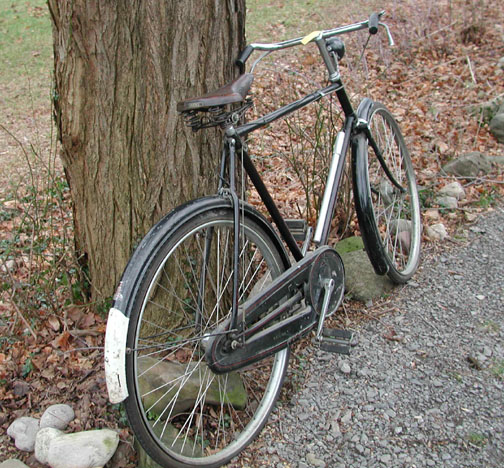
Photo 5. Flat tires and missing the reflector
This photo shows the 1950 Raleigh roadster (serial number: AV 28223) as it appeared when I brought it home on Saturday December 2, 2006. Complete with two flat tires, and the rear reflector and rear Dynohub tail light lens both missing. Otherwise, it looked intact and seemed to be fitted with all OEM parts.
Photo 6. Original Brooks model B73 leather saddle
It features a full chain guard, an aluminum air pump stamped, "MADE IN ENGLAND", a Brooks "GENTS MODEL B73" leather saddle, 3-speed (Sturmey-Archer model "AW") rear hub gears, roller-lever "rod" brakes, and a 6 volt, 2 or 3 watt * Sturmey-Archer (model GH6) Dynohub AC generator.
* The Dynohub output level of 2 watts contradicts much of the information available on the internet, which suggests it is 3 watts. According to The Story of the Raleigh Cycle (authored by Gregory Houston Bowden / published in 1975 by W. H. Allen & Co. Ltd.) "in 1946 Raleigh incorporated a number of new features. Sturmey-Archer produced a new type of three and four speed hub with a dynamo built into it. The new hub and the old-type front-wheel dyno-hub had an electrical output of 2 watts as compared to the pre-War 1¼ watts."
Photo 7. The three speed AW hub was made in February 1950
The rear hub is stamped with "50", "2", and "AW", which designates the year (1950) and month (February) of manufacture, as well as the model (AW) of the hub itself. The bike did not have a kickstand or saddle bag.
I discovered the bike on Thursday November 30, 2006, in an antique shop in Rochester. I was waiting for my car (1982 Mercedes-Benz 240D) to be repaired, and rather than sit in the waiting room for three hours, decided to enjoy the unusually warm weather (65°) and walk around the urban landscape. After pondering the bike for a while, and also talking to the seller directly on the phone, I walked over to Towner's Bike Shop and asked a few questions regarding the availability of parts, its value, and so forth. What they told me was not very encouraging, but that night when I got home I continued to do more research on the internet, especially regarding its value, because I did not think it was worth what he was asking. It was marked $495, which was way out of line, but fortunately, there was a "50% off" sale that brought the price down to a more reasonable $250. When I talked to him on the phone, he said he would take $225. I tried to get him to take my 1968 Hercules in trade, but he was not interested. I also went to a bicycle repair shop near my home and got some suggestions on where to find the missing bits, as well as some sage advice on evaluating its worth. Basically, it is worth the price if you want it bad enough!
The next day, Friday, I went back to the antique shop to scrutinize it again, but this time, armed with a bit more information on what to look out for. I definitely liked what I saw, but figured I did not need another specialty bike, especially for that price. It felt good to have finally reached a decision! But later that night, I was e-mailing a bike shop in Toronto (Bicycle Specialties), and was referred to a website in England (The Old Bicycle Company Showroom) so that I could make some comparisons. After seeing the prices (with the currency exchange rate factored in) and condition of the bikes in England, I decided the bike I found was not such a bad deal after all. So, wearing my rose tinted spectacles, I brought it home with me on Saturday December 2, 2006.
Initially, the tires were flat, but I soon discovered they held air, so on Sunday December 3, 2006, I took it for its maiden voyage. The skies were dark and overcast, the roads were dry, and the temperature was at the freezing mark. For the first few minutes, I had some difficulty controlling the handle bars because they are narrow, and positioned very close to the saddle, thus making for a more upright, and unfamiliar riding position than what I was accustomed to. After a few stumbling starts, I managed to head off to a nearby trail. The gears shifted and performed well, and there were no untoward noises coming from the chain or anywhere else. The free-wheel clicking of the rear hub sounded good to my layman's ears. Not too dull (a sign of dried-up, or too thick an oil) and not too bright (a sign that too light an oil had been used). The wheels spun true, but the performance of the rod brakes seemed a bit antiquated – making it difficult to stop, compared to modern bikes. The Brooks "gents model B73" leather saddle was not too comfortable at first, but it scored massive points for adding to the overall retro feel and appearance. In general terms, I had purchased an old gent's bike, in good condition.
When I cleaned and polished the fenders and frame, the white rag picked up a lot of brown grime that had settled onto the paint. I then used saddle soap and mink oil to rejuvenate the leather Brooks saddle. It came out real well and the mink oil has a nice smell. I then learned about a product made by Brooks called, Proofide, which is designed specifically for cleaning these leather saddles. I ordered a kit that included the Proofide, a cleaning rag and a spanner (wrench) to adjust the tension of the leather seat. The Brooks company is still in business today, but a good leather saddle is not cheap. I used Kiwi brand black shoe polish to spiff up the tires a bit, as they were browning around the edges, from lack of use, more than anything else. I applied the shoe polish with a rag and wiped down the tires afterwards. This will have to suffice, until I order new tires.
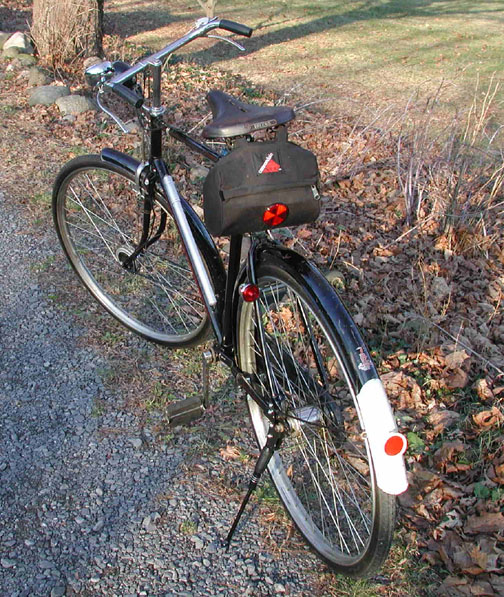
Photo 8. 1950 Raleigh roadster - renovated condition - December 16, 2006
Camera: Nikon Coolpix 990
This photo shows the new items since the previous photo was taken, a fortnight ago. Notice the rear reflector. I sourced this from a bike shop on the west coast. It was in good condition, but the reflector housing (escutcheon) should be made of black rubberized material to be period correct. I sourced one from England, but still need to install it. Additional appointments: adjustable kickstand (modern), front and rear Fibrax (OEM) brake shoes, saddle bag (Cannondale, circa 1985), a chrome bell mounted on the handlebar, and the rear Dynohub light (circa 1960-1970) I also used black shoe polish (Kiwi brand) on the tires. From what I understand, the 28" tires were only ever supplied in black. Smaller tires were also offered with gum wall sides. The Cannondale saddle bag dates from the mid 1980s and can be crammed with all sorts of tools and extra bits. When the saddle bag was new, I used it on the handlebars of the 1968 Hercules. In any event, the bike cleaned up very well, with a wonderful patina, commensurate with its advanced years.With the bike having been stored in the stable for a few days, my initial impressions were that it was a rare period survivor with a certain amount of panache and road presence, but somewhat less forgiving than modern bikes. That is to say, the 24" frame and the 28" x 1 ½" (635 mm) tires make it one of the tallest bicycles I have ridden, thus leaving very little room for "operator error" when coming to a standing stop, or simply standing astride the bike. The rod brakes leave something to be desired as well. Stops must be planned well in advance, or else risk embarrassing oneself, or crashing into the scenery (one would imagine). Obversely, by virtue of its tall stature and road manners, which demand the cyclist be skillful and focused, this mid-20th century British roadster places one into a class virtually all by themselves, both on converted canal and railroad bed trails, and out on the open road. Note to self: Some additional vintage accessories for future rides may include leather riding shoes, a tweed sport coat, and a pipe to clench in my teeth whilst riding to the pub for a spot of grub. Note the circa 1985 Cannondale "Toot" saddle bag.
One of the curious features of this bicycle is the Sturmey-Archer Dynohub. This one happens to be a model GH6. It is a 6 volt AC electric dynamo (generator) located in the front wheel hub used to power the head and tail lamps. I verified the Dynohub was indeed functional by hooking a meter to the output terminals of the front hub and spinning the wheel by hand. However, the bulbs were intermittent. Upon further investigation, I determined that one of the lug crimps inside the head lamp assembly was loose and causing the problem. Specifically (for reference) the 6 volts was not getting to the base of the head lamp bulb socket. I also found that when either the front or rear bulb is removed from the circuit, the other bulb does not light. Both bulbs must be working to complete the circuit. This contradicts some web page I read that suggested that if one bulb blows, the life of the remaining bulb will be shortened due to the higher voltage. Maybe that was for a later Dynohub model or circuit configuration.
Also, the generator circuit shorted whenever the chrome bezel was placed on the head lamp assembly. I discovered, after considerable time spent trying to figure it out, the concave head lamp reflector was touching the hot terminal of the switch inside the assembly. So I used electrical tape to prevent the reflector from touching that terminal. When I opened the head lamp up the first time, some old electrical tape fell out. It might have been used for the same reason.
I have found documentation on the internet that suggests the GH6 Dynohub puts out 3 watts of power. That is not much, and the bulbs for the headlamp and tail lamp need to be chosen carefully so as not to go over this limit. The challenge begins when you realize that modern bulbs are not readily available in the original specification sizes. Let me start by posting the original values as found on the piece of paper glued to the back of the concave headlamp reflector. The reflector is the part the bulb pokes through and focuses the headlight beam. The original sticker on back side of head lamp reflector says:
Bulbs
Head 6V .25A
Tail 6V .04AThe .04A is not a typographical error. That is how it appears, very clearly printed, on the sticker. The interesting thing was that the bulbs I found in the sockets correspond exactly to these values. Here are the values of the bulbs I found in the bike when I got it:
Head lamp bulb (screw base) data stamped on base
"CRY5 ENGLAND 6V 0.25"
Tail lamp bulb (screw base) data stamped on base
"CRY8 ENGLAND 6V .04"Thus far, the paper sticker in the headlamp assembly and the bulbs were a perfect match, but they were not working. The tail lamp bulb glass was broken, so that was obvious, and the headlamp had a loose connection, which took more time to diagnose.
The following data and narrative are the result of a continuing search for a source of modern replacements for the head lamp and tail lamp bulbs.
Bicycle Specialties in Toronto said replacement bulbs should be
Head lamp: 6V 0.2 A (1.2W) (screw base)
Tail lamp: 6V 0.1 A (0.6W) (screw base)
A trusted European automotive lighting specialist and bicycle enthusiast said the replacement bulbs should be
Head lamp: 6V 0.4A (2.4W) (screw base)
Tail lamp: 6V 0.1A (0.6W) (screw base)Harris Cyclery sells the correct style glass bulbs with what seems to be the values that are generally considered correct.
Head lamp: 6V 0.4A (2.4W) (screw base)
Tail lamp: 6V 0.1A (0.6W) (screw base)The generally accepted tail lamp values work fine. However, the head lamp bulb does not produce much light at all. It is nearly impossible for the cyclist to see anything on a dark country road with the 6V 2.4W head lamp.
I tried using a standard Type 40 lamp (bulb), which is 6.3V 0.25A (1.5W) (screw base) and it produced about 300% more light than the 6V 0.4A (2.4W) (screw base) bulb. This increased light is still barely enough to see what is in front of the bike when traveling down a dark country road, but so far, the Type 40 bulb is the brightest one I have tried. They are readily available at antique radio specialty stores and are commonly sold in boxes of 10 each.
Reflectalite, Ltd. (England) (company dissolved March 18, 2025) was found to have replacement bulbs for the Dynohub generator. Reflectalite said, "Dynohubs are not 3W, they are more like 1.5W to 2.0W." This corroborates the passage from The Story of the Raleigh Cycle, which says the Dynohub was increased to 2 watts in 1946. The bulbs Reflectalite Ltd. has available (as of December, 2006) for the Dynohub are: GH107 for the headlight and GV601 for the tail light. This gives a brighter tail light than the original, and using the GH107 (halogen) for the headlight gives a whiter light and makes the best use of the limited power available. Further, he stated, "Note that GH107 is 5V 1.5W, but it works okay and has been well tested."Head lamp bulb: "GH107", halogen, Screw-cap, 5V, 1.5W (0.3A), $6.40 each.
Tail lamp bulb: "GV601", incandescent, Screw-cap, 6V, 0.1A, 0.6W, $1.28 each.
Shipping (airmail) $3.20 per small package to USA.Summary Notes on Dynohub Head Lamp Bulbs
- All testing was performed at night on a dark country road
- Since testing was done on a dark country road, the results will be much worse on roads with street lamps and traffic
- None of the head lamp bulbs tested were capable of producing a sufficient amount of light so as to illuminate the road in any real useful way
- Of the head lamp bulbs tested, the Type 40 lamp (6.3V, 0.25A, 1.5W, screw base) seemed to produce the most light on the road when moving at about 10 mph, but the light looked yellow and anemic
- The GH107 lamp (5V, 1.5W, 0.3A, halogen, screw base) may produce a slightly more white light than the Type 40 bulb, so I will use the GH107 in the Dynohub head lamp
- I conclude that the Dynohub head lamp was never meant to provide a useful amount of light for the cyclist, but merely provided a way for other cyclists and motorists to see the rider with the Dynohub generator
04-dec-2006:
07-dec-2006:
11-dec-2006:
The tires are marketed through Pyramid but manufactured by Kenda in Taiwan. They are labeled with maximum pressure of 50 p.s.i. The tubes are also marked through Pyramid and have Schrader valves.
12-dec-2006:
15-dec-2006:
17-dec-2006:
Notes:
- Phil Woods Grease can not be used at the foot pedal grease zerk because there is no easy way to inject the grease into it. The hub and pedal drive unit need to be disassembled and the old grease removed. Over packing the hub and drive unit with grease will make the seals blow out. Phil Woods Tenacious Oil should be used on the chain.
- The head lamp value of 6V 0.4A (2.4W) (screw base) is generally accepted as "correct" for 6 volt 3 watt Dynohubs, but does not produce much light at all on my particular bicycle. The light can barely be seen by a pedestrian walking along a dark country road with no traffic, and does not provide enough light for the cyclist to actually see the road in front of them.
- The Fibrax SH70 brake shoes could not be used without adding a spacer so that they were farther inboard to make 100% contact with the wheel rim. The only hardware the Type SH70 shoes came with was a flat washer and a nut. I previously purchased two sets of Fibrax SH144 shoes (BHB - Oregon) each of which included a nut, a lock washer, a flat washer and a metal spacer. I used the hardware from the SH144 brake shoes on the SH70 brake shoes to make a perfect fit on the front wheel.
- The previously purchased Fibrax SH144 brake shoes (BHB - Oregon) did not fit the front wheel correctly because they came in contact with the valve stem nut and the spokes. But they worked perfectly on the rear wheel. So I decided to use the Fibrax SH70 brake shoes on the front wheel (with the mounting hardware from the SH144 shoes) and the Fibrax SH144 shoes on the rear wheel.
19-dec-2006:
23-dec-2006:
24-jan-2007:
Jon Sharratt (ABCE / All British Cycling Event) supplied these parts.
08-feb-2007:
My wife got me the following item for my birthday.
07-mar-2007:
Peter Paine (England) supplied these parts.
17-aug-2016:
Had a blowout on the rear tire while riding the Lehigh Valley Trail somewhere between Chambrelain Road and Quaker Meetinghouse Road. Started walking home, but got hold of my sister who met me at the Bloomfield Road trail head in her 1998 Jeep Wrangler.
18-aug-2016:
Dropped bike at Mendon Cyclesmith in Ionia. Provided new tires and tubes, which I purchased about 10 years earlier.
22-aug-2016:
Picked up bike at Mendon Cyclesmith in Ionia. The tubes I provided were a bit narrow, so he used slightly wider ones. Both sets (the ones I provided and the ones he used) had Presta valves. Not sure why I bought them 10 years ago. He said it was laborious. Spent 45 minutes on the front, and 1.5 hours on the rear with the R&R of the full chain guard. The brakes can't be just pried apart, and they didn't want to chip tha paint, so it took a little extra time. The bill came to $50.
Rolling Total:
06-jul-2018:
Dropped bike at Mendon Cyclesmith in Ionia. Had flat tire on rear yesterday. Not a blow-out, but it was flat when I went to go for my second ride of the day. Asked Craig to find some better tires and replace the tubes with ones that have Schrader valves. He ordered Schwalbe "Marathon Plus" tires and tubes with Schrader valves.
07-jul-2018:
Bought a 2 oz. bottle of DuMonde Tech Original Chain Lube (lubricant) at Mendon Cyclesmith in Ionia for $8.00. Since he has a gallon of it, he said refills are $7.00. Applied to chain and it remained wet for a number of rides. Has a nice smell too. May use it as an after-shave.
11-jul-2018:
Bought a 4 oz. bottle of Finish line Wet Bike Lubricant (synthetic chain lubricant) at REI CO-OP (450 E. Henrietta Road) for $9.00. Yet to be tested.
14-jul-2018:
Picked up bike at Mendon Cyclesmith in Ionia. Had two new Schwalbe "Marathon Plus" tires ($55.00 each), and two new tubes with Schrader valves $8.00 each). Labor: $60.00, tax: $14.88. GRAND TOTAL: $200.88.
18-jul-2023:
Ordered a "Small flip top cup oiler - 1/4" BSF" from www.vintagecarparts.co.uk
Description: Small flip top flap oiler, self colour brass finish, 1/4" (6.6mm) hexagon, 1/4" x 26 TPI thread (1/4"BSF), only 6mm tall. This oiler is particularly used on bicycles.
https://www.vintagecarparts.co.uk/products/ca480-small-cup-oiler
£3.90 + £14.25 freight = £18.15 = $24.79
Here is a price comparison for the Brooks "Millbrook" carry-all saddle bag. Using the three examples shown here, I would use "Wallingford Bicycle", unless the "Old Bicycle Showroom" had something that was simply unavailable in the USA, such as inner tubes with metal stem Schrader valves, etc. Also, freight will be higher from England when compared to U.S. ground rates.
- Brooks Millbrook - Harris Cyclery (USA): $89.95 USD + freight
- Brooks Millbrook - The Old Bicycle Showroom (UK): £40.00 ($78.14 USD) + freight. As of 26-dec-2006, 1.00 GBP = 1.95357 USD
- Brooks Millbrook - Wallingford Bicycle (USA): $78 USD + freight
Photos 9a, 9b. Looking for the clear, plastic cover for Sturmey-Archer 3-speed
trigger shifter.
Photos of Sturmey-Archer shifter posted June 21, 2018
Photos from June 17, 2007
The next three photos show the 1950 Raleigh Roadster ("Sir Walter") with a few new period appointments. Notice the NOS black Midland (England) "Roadster Model" presstube rear luggage rack, the reconditioned Brooks leather saddle, handlebar bell, saddle bag, kickstand, period reflector on the rear mud guard, and functioning Sturmey-Archer Dynohub lamps at the front and rear.
Photo
10. 1950 Raleigh
3-Speed English Roadster - refurbished condition - June 17, 2007
A "Tourist Model 2" a.k.a. "DL-1"
24" frame with 28" wheels
Camera: Nikon Coolpix 990
Photo 11. Note the NOS black Midland "Roadster Model" presstube rear luggage rack
Photo 12. The rear fender reflector (in black, rubberized housing) was sourced in England and shipped to New York
Note the circa 1985 Cannondale "Toot" saddle bag
Photo 13. Two of my favorite summer rides!
1957
Mercedes-Benz Type 190 sedan – in the stable since June 17, 1989
(sold June 24, 2016)
Camera: Nikon Coolpix 990 / July 9, 2009
Update: September 20, 2011 – Finally made it to Via Bicycle in Philadelphia. Spoke briefly with Curtis Anthony, who seemed to be running the place, but they were so busy there was little time to hobnob. Here is a photo of the exterior.
Photo 14. Via Bicycle Sale and Service / 606 South 9th Street / Philadelphia 19147
(former address)
Camera: LG Rumor Touch - Sprint cell phone / September 20, 2011 / 2:02 p.m.
Photo 15. The
Mendon Cyclesmith (Mendon, NY)
Camera: LG Rumor Touch - Sprint cell phone / October 21, 2011 / 9:45 a.m.
Photo 16. Lehigh Valley trail / Mendon, NY
Camera: LG Sprint cell phone / Saturday June 2, 2012 / 4:09 p.m.
Photo 17. 1950 Raleigh DL-1 roadster on the Lehigh Valley Trail
/ Victor, NY
Camera: LG Rumor Reflex cell phone / Monday October 20, 2014 /
9:41 a.m. / 49° F
Had the day off from work, so rode to the Fishers Post Office (3.2 miles return). Note the white flowers in bloom!
Photo 18. 1950 Raleigh DL-1 roadster at home
Camera: iPhone
6 / Wednesday October 7, 2015 / 12:20 p.m. / 67° F
Took a leisurely lunch-hour ride on the Lehigh Valley Trail over to W. Bloomfield Road (county road 66)
Photo 19. 1950 Raleigh DL-1 roadster on Lehigh Valley Trail at
Chamberlain Road
Camera: iPhone 6 / Saturday July 23, 2016 / 5:33 p.m. / 87° F
Photo 20. 1950 Raleigh DL-1 roadster on Lehigh Valley Trail
near Clover Street
Camera: iPhone 6 / September 1, 2016
Flowers: Purple Loosestrife (Lythrum salicaria) – an invasive weed. Also shown: Goldenrod.
Photo 21. 1950 Raleigh DL-1 roadster on Lehigh Valley Trail
near Clover Street
Camera: iPhone 6 / September 1, 2016
Photo 22. 1950 Raleigh DL-1 roadster on Lehigh Valley Trail
near Quaker Meeting House Road
Camera: iPhone 7 (first photo with the new
phone) / November 8, 2016
Update: June 1, 2023 – First ride of the season on the DL-1. Heard a rather loud, rotational, clicking down near the crank. Called the Mendon Cyclesmith from the trail, and he said to check the "cotter pin" nut on the crank (what—a cotter pin?), and sure enough, it was loose (see photo). In case you don't know, the "cotter pin" is more akin to a tapered bolt. Tightened the nut with a small adjustable wrench from my saddle bag, and the clicking ceased. Also tightened the extremely loose nuts on the rear rod brake lower bracket (see photo). Not only that, the adjustable cup lock ring (knurled) was also only finger-tight (see photo). When I got back home, used a large, flat blade screwdriver in one of the lock ring slots, and gave it several smart taps with a hammer.
Photos 23, 24, 25. 1950 Raleigh DL-1 roadster – fixed rotational clicking noise, etc.
Camera: iPhone 13 / June 1, 2023
Photo 26. Definitely not an English Roadster
Schwinn
model: "191 CL RST OMNI" (name on front forks) aluminum frame, 16-speed, off-road hybrid
Camera: LG Rumor Touch - Sprint cell phone / March 9, 2012 / 07:28 a.m.
This Schwinn 16-speed, off-road (hybrid) has been fairly reliable with the exception of a few broken spokes, and (more seriously) a broken frame – where the seat post slides into the frame. On the detail photo, see the aluminum weld by Hansen Metalworks of Farmington, NY. They also lengthened the seat post to avoid having the same problem again. This was a Walmart special around 2004, and cost something like $169. The plastic mud guards, and water bottles were after-market accessories.
October 24, 2013: Due to the onset of an almost constant skipping of the gears, the Mendon Cyclesmith replaced the following on the Schwinn. Total came to $132.84.
- Sprocket (rear cassette / a.k.a. gears)
- Chain (had stretched, causing significant gear wear)
- Crankset (front gears and crank arms [where pedals attach])
- Pedal (original left pedal would not come off old crankset)
- Spokes (two on rear wheel)
- Tube (rear)
Photo 27. Loaner: Surly Krampus "lefty" with fat tires and Brooks leather saddle
Camera: LG
Rumor Reflex - Sprint cell phone /
October 24, 2013 / 4:56 p.m.
October 24, 2013: Craig (Mendon Cyclesmith) loaned me a Surly Krampus "lefty" while my Schwinn off-road hybrid was being repaired that afternoon. The Krampus model uses 29" wheels and 3" tires. The term "lefty" comes from the front fork design (see enlarged photo). This bike was fitted with a narrow Brooks leather saddle. With the slightly under-inflated fat tires, the Krampus seemed a bit unwieldy out on the Lehigh Valley Trail (a flat, gravel path), and the front shock absorption was surprisingly cushy. Only had time to make a single, four-mile round trip from the shop to my house and back again. He had a shipment of brand new (some still in the box) Surly bikes at the shop – priced around $1,600. Another popular Surly model is the Pugsley, which uses 26" wheels and 4" or 5" tires.
Photo 28. June 20, 2014: Broke the Schwinn
freewheel shaft
(a.k.a. rear axle pass-through bolt).
Ordered a new one at the Mendon
Cyclesmith, and installed it June 26, 2014. Cost: $15.
Photo 29. August 18, 2015: Detail of the aluminum weld by Hansen Metalworks of Farmington, NY in March 2012
Photo 30. October 22, 2015. Certain teeth of the Shimano freewheel were badly worn after only 16 months of regular use.
Freewheels cost about $20, so Craig at Mendon Cyclesmith (new location in Ionia, NY) ordered a new one. The new Shimano freewheel was installed October 29, 2015 at Mendon Cyclesmith.
30-oct-2015: Had a grinding in the gears, so adjusted the barrel adjustment at the rear derailleur to no avail. Ended up getting a new chain at Mendon Cyclesmith ($20 installed). Problem solved.
Photo 31. "Solas 30" rear light (30 lumens). USB-chargable.
The Solas 30 illuminates red when charging, and turns blue when fully charged (see photo). Purchased October 22, 2015 for $30 at Mendon Cyclesmith.
Photo 32. Lezyne 600 XL Macro Drive headlamp. 600 lumens.
USB rechargeable, internal Li-Ion battery
Purchased October 29, 2015 for $52 at Mendon Cyclesmith.
Photo: October 29, 2015 / iPhone6
10-jun-2019: Tried charging the Lezyne 600, but the green light continued to blink (charging mode) for a long time. Took it off charge, and it was not working at all. Called Mendon Cyclesmith. and he said Lezyne has good customer service, and suggested using them. Contacted Lezyne and sent the 600 XL Macro Drive to customer service (San Luis Obispo, California 93401). The Lezyne page suggested returning this particular model because the battery is not easily removed. If the problem is only the battery, the cost will be $20 including return shipping.
19-jun-2019: Got email from Lezyne. Called them, and spoke to Thomas. The problem was indeed the battery (Li-Ion), and they replaced it. Cost was $20 including return shipping.
He said the Li-Ion battery constantly draws current even when the light is off, so it needs to be charged occasionally during the "off season", or when a light may not be needed (summer, etc.) My problem was that I didn't use the light (or ride the bike) for eight months (from October 2018 to June 2019). REMEMBER: If the Li-Ion battery just sits without being charged periodically, it may (depending on the age of the battery) cease to work at all.
24-jun-2019: received the Lezyne 600 XL Macro Drive headlamp back from service. Worked fine and took a full charge.
03-feb-2016: Rear brakes were dragging. Then noticed a wheel wobble. Another broken spoke. Ended up getting a new spoke at Mendon Cyclesmith ($10 installed) on 04-feb-2016. Problem solved, but the price to replace a spoke doubled since the last time.
01-jun-2017: Rear tire would not hold air. Got new tires and tubes. Continental "TravelCONTACT" tires (26") were $35 each. Installed while I waited at Mendon Cyclesmith ($101.52)
Photo 33. June 1, 2017: New Continental "TravelCONTACT" tires (26")
Photo 34. New Continental "TravelCONTACT" tires (26")
Photo 35. June 7, 2018: New rear wheel and axle. The original hub was worn out.
Price for complete new wheel (with hub/axle): $40.
Mendon Cyclesmith (Craig) added some grease to the new hub before I picked it up.
Photo 36. Schwinn on Lehigh Valley Trail near Clover Street / July 31, 2018 / iPhone 7
30-jul-2018: Brought bike to Mendon Cyclesmith for what seemed like the chain skipping on the freewheel cassette gears. Possibly needed a new chain, cassette, and "rings" (front gears). They were last replaced October 29, 2015. He checked the chain with a gauge, and it was fine! Looking closer, he tightened the crank (trying to eliminate any possible untoward noises), and tightened the bolts on the rear wheel, and lubed the rear shifter cable (removed the sheath) all the way from the front of the bike to the rear, and also cut a new length of shifter cable going to the rear derailleur. He said it was binding, which would make it shift harder. He also trued up the rear wheel by adjusting a couple of spokes. He also adjusted the indexing so it easily shifted into all 18 ratios. Charge for everything - while I waited: $5.00.
However, riding later that day revealed the "skipping" problem had not been properly resolved. The actual problem was that the gear shifter was late in changing from 5 to 6. For example, when I thought it was in top gear (6), it may not have been - until some time later, when it unexpectedly changed with an unanticipated "clunk", which seemed like the chain was skipping. At least I knew that the chain was not stretched and the cassette was in good condition. It only hesitated going from 5 to 6 (rear gears), and did not occur going up or down through any other gears.
Craig replied, "If all other gears drop or climb well, it's likely the derailleur is getting sticky/cranky. Try a bit of lube on the parallelogram pivot points, and work it a bit. Otherwise, that's all spring based movement going towards harder gears, and the springs do get "tired" and do that after a while, and it's almost always, that last drop that shows itself as problematic. Cheap fix beyond lube? Accept that it's slow, and lessen pedal pressure till it actually drops, then get back into it."08-aug-2018: The front tire was flat when I went out for a ride, so replaced the tube with a new spare from the basement. The old tube was a Kenda standard 26 x 1.9/2.125 with a Schrader valve. Found a new Bell standard 26" tube (boxed and sealed) with Scrader valve in the basement, so made the swap and went for an 11.5 mile ride. Later, got two replacement tubes (Schrader valves) at Walmart for $4.64 each.
12-aug-2018: The front tire was flat when I went out for a ride ("déjà vu all over again"), so replaced the tube with a good, used spare (with Schrader valve) that was hung on the basement wall when I got the Continental tires on June 1, 2017. The tube that went flat was the NOS Bell standard 26" tube (boxed and sealed) with Schrader valve found in the basement four days earlier.
16-aug-2018: The front tire was flat when I went out for a ride (not again!), so replaced the tube with a new spare (with Schrader valve) purchased at Walmart on August 8, 2018 (eight days earlier). The tube that went flat was the one that was hanging on the basement wall from when I got the Continental tires on June 1, 2017.
04-oct-2018: About 6:00 p.m. - the rear tire slowly went flat while heading east on the Lehigh Valley Trail just west of Chaimberlain Road (again - what is it about that area?). Wanted to attend a lecture at 7:00 p.m. at the town hall, so in desperation decided to call my friend and neighbor Chauncey to pick me up. Rode the bike to the West Bloomfield Road trailhead where he arrived in his brand new Chevrolet Colorado pick-up truck. Loaded the bike into the back. We were both able to attend the lecture, which was: Historic Advisory Committee Lecture Series: "Haudenosaunee: People of the Longhouse," by Harvey Limbeck, Docent at Ganondagan.
05-oct-2018: Replaced the tube in the rear tire. Also used gasoline and a heavy brush to degrease the rear derailleur and cassette.
08-oct-2018: Had two flats when I went out for a lunchtime ride. Got fed up with changing tubes, and brought the bike to the Mendon Cyclesmith to possibly get a new set of tires. He convinced me that the only thing I needed to change was my method. When changing tubes, need to check the inside of the tire for objects embedded in the rubber. He removed two stone shards in the front tire and one in the rear, and then proceeded to replace the tubes. Per my request, he installed a new Shimano Acera rear derailleur ($40). Also got a new Lezyne air pump ($35) and a tire patch kit ($3). Total came to $95. Even though it turned out to be a nice sunny afternoon with temperatures in the lower 80s, was unable to go for a ride.
New Shimano Acera rear derailleur / 08-oct-2018
New Lezyne "Alloy Drive" (Presta and Schrader valve) air pump (affixed between the frame and water bottle boss) / 08-oct-2018
The Lezyne Alloy Drive website list price was $49.99, and said, "A lightweight hand pump for high volume tires, with an integrated gauge and valve core tool. Lightweight, CNC machined aluminum construction. Efficient and compact overlapping handle optimized for high volume applications. Equipped with Presta and Schrader valve compatible ABS Flex Hose with integrated valve core tool. Includes a composite matrix frame mount."
08-oct-2018: Went back to Mendon Cyclesmith for a longer set of 5 mm thread Allen key bolts to go through both the water bottle boss and the air pump mount.
13-nov-2018: Had a puncture on the rear tire at the end of an otherwise good 12 mile ride. Went flat near the Mendon baseball diamonds. Had to hoof it back the last mile in the blowing snow flurries. Tried using the new tire pump, but the hole in the tube was too big. Craig at Mendon Cyclesmith ordered two new Continental "TravelCONTACT" tires (26"). They were last replaced in June 2017, but had about 1,900 miles on them (rode 306 miles in 2017, and about 1,600 miles so far in 2018). Opted to replace only the rear tire, so Craig mounted it on Friday November 23 (a.k.a. Black Friday). Price for one new tire and tube: $50.
03-sep-2019: Had a flat tire in the garage (on the front) when I set out to go for a ride. Removed the tire and tube and felt around the inside of the tire for shards of stone, etc. One sharp piece of stone fell off the tube, but none were found embedded inside the tire. Replaced the tube and went for a short ride. Turned around between Chaimberlain and Bloomfield Roads.
"An early lugged, steel-framed road bike made by the Trek Bicycle Corporation in Waterloo, Wisconsin."
This Trek bicycle was purchased brand-new on Friday, March 27, 1981 from the Park Avenue Bike Shop (211 Park Ave / Rochester, NY) for $365 plus $25.55 tax (total = $390.55), which was (but not so much anymore) a hefty sum for a bike. Adjusted for inflation, it comes out to about $1,349.85 in 2024. In August 2024, it was still 100% original, and had been kept in dry, heated storage for about 35 years. The last time it saw regular use was about 1989. It was brought out of storage for these photos (iPhone 6) on October 6, 2015. The sales receipt states: Serial Number M1B8C49, which seems incorrect – compared to the photos. It also states: "24½" Grey Trek / Model 412 / toe clips & straps." It was purchased with my first Kodak bonus, which would have been received about a week earlier.
Photos / October 6, 2015 (iPhone 6) / Flat tires, disintegrating Dia-Compe gum brake lever hoods, original cloth handlebar tape, Trek head badge, and model designation sticker. Notice what it does not have: mud guards, kick-stand, luggage racks, etc. It was a functional, durable, light-weight, bare-bones road bike.
When replacing the brake lever hoods, remember Dia-Compe was OEM to this bike. Everything from the brake levers, to the hoods, to the calipers, right down to the pads are stamped "DIA-COMPE." In 2015, Dia-Compe sold gum-colored, replacement lever hoods for about $10.00 a pair.
After sitting in the basement for 25 years, the tires were pumped up, which held air, but the sidewalls were cracked. Cycle Cross (CX) tires could be fitted – provided enough brake clearance. CX tires would make it easier to ride on the Lehigh Valley Trail than the narrow and bald (by design) tires that came with it in 1982.
According to the Vintage-Trek website the Ishiwata 022 steel frames were less expensive than Reynolds or Columbus-tubed frames, but the steel quality was equal to the others. They are often described as "best value."
Trek (Ishiwata model 022)
Serial Number M4B8C49
Deciphering the Serial Number
M = model 412 or 414
4 = 24" frame
B = February
8 = unclear meaning. Most of the 412 and 414 frames were made in 1980 and 1981.
C49 = see Vintage-Trek website for explanationSkip, of the Vintage-Trek website said, "The leading M means the bike is a Trek model 412 or 414. The frames are the same for 412 and 414 bikes, only the component groups are different. The unclear part is the date of these 412/4 frames. The fourth character does not have they typical year meaning. The vast majority of these were made in 1980 and 81. None were made in '78.
The specs for these bikes are in the 1980 Trek catalog.
Photos / October 6, 2015 (iPhone 6) / Trek model 412 or 414 / Serial Number M4B8C49 – as found on the underside of the bottom bracket.
Photos / October 6, 2015 (iPhone 6) / Original Avocet seat, and Zefal "hp" air pump
Photos / October 6, 2015 (iPhone 6) / Other features included 27" Rigida (France) wheels, Presta valves, and Avocet toe clips. The bike was all original right down to where the rubber meets the road. The tires still held air, but the sidewalls were cracked. Always a casual-use fitness tool, decisions were made whether to clean and refurbish, and press it back into service, or just place it back into storage.
More To Come...?
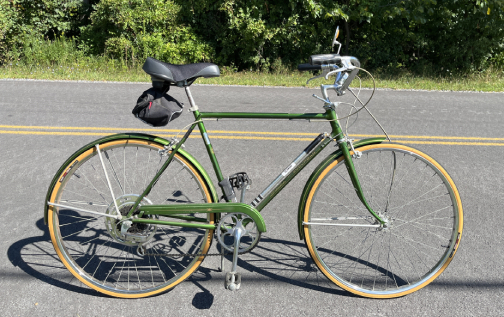
Features / Specifications
25-aug-2025 (Monday): Purchased this 1971 Schwinn Suburban 5-speed for $80.
- Color: Campus Green.
- Frame size measured: 22".
- According to bikehistory.org, Schwinn serial number JG007953 was stamped in September 1971.
- Schwinn speedometer/odometer (working condition) by Huret (France).
- Missing the reflector. The correct reflector is a 2 ¼" diameter 6-pie Gulco 22.
- Had a newer (circa 2000 – 2015?) Schwinn, wide, comfort saddle.
- The correct saddle (see photos).
- Tire pump "Schwinn Approved / France."
- Tires: Serfas® model Pacer (MEO series) – 27" x 1 ¼" nylon cord gumwall road tires (see Tire History)
- Brakes : OEM brake shoes (rubber, orange/salmon, 6-dot) were made for Schwinn by Weinmann (Switzerland).
- Brakes (Weinmann facsimile replacement): www.modernbike.com/koolstop-weinmann-6-dot-brake-shoes-salmon-bag-of-4
History
22-aug-2025 (Friday): Discovered this bike hanging from the rafters of a friend's attached garage in Canandaigua, NY, and I quickly expressed an interest in buying it. Learned that my friend was storing it for his friend. My friend texted his friend to check on the price, and the reply was, "$100 or whatever you can get." By the time we returned from the event (the main reason for visiting), it was too late to get it down off the hooks, and look any closer at it, so we decided to follow-up the following week.
25-aug-2025 (Monday): Circled back after the weekend, and learned the owner lived in Clifton Park, NY – about 200 miles to the east, near Albany. Allegedly my friend had been storing it for "about four years." Rode the bike, and offered $80. My friend texted the owner, who agreed. Supposedly, his friend was the original owner, and had the owner's manual. I then communicated directly (via cell phone text) with the owner to give him my address so that he could forward the paperwork.
26-aug-2025 (Tuesday): Posted a check for $80 to the owner.
29-aug-2025: Got a text from the owner saying he received my check, and the owner's manual was in the mail.
Reflector
The correct reflector is a 2 ¼" diameter 6-pie Gulco 22 with a backing bezel stamped for lightweight fenders (it should have a faint "LW" stamped on the face of the bezel).26-aug-2025: Paid $44.95 + $3.37 tax, (free shipping) = $48.32 (eBay – Buy It Now) for the correct reflector. Vendor: "a_c_green" (Andy).
2 ¼" diameter 6-pie Gulco 22 reflector / eBay / August 26, 2025
Installed August 29, 2025 / iPhone 1325-aug-2025: Description of the correct reflector for a 1971 Suburban provided by eBay seller "a_c_green" (Andy).
Schwinn part number 07 778, made for Schwinn beginning in the early 1970s by the Gulotta Division (or Gulco) of Bright Star Industries, and used on various Schwinn models in the early 1970s. Later examples of this reflector would carry an SAE 1971 compliance, labeled as such on the front of the lens ("SAE A - 71"), but this early example shows only "SAE - A" and was first issued in or around 1970.25-aug-2025: Communication with eBay seller Andy a.k.a. "a_c_green" (edited for context, and clarity).
Reflector area is 2¼" in diameter on a Bright Star No. 2222 aluminum backing, and 1¾" diameter lightweight fender bezel. This provides a full rear fender mounting, including the correct backing bezel curved to fit the profile of a lightweight bicycle fender. The bezel's curvature is too tight to fit a middleweight fender. Both the reflector, and its mounting bezel have been polished and waxed.
This reflector kit includes
- Gulco 22 6-pie reflector: 2¼" diameter, 2-pie lens and #2222 aluminum backing
- Chrome backing bezel: 1¾" diameter, for lightweight rear fender
- 10-24 mounting nut and lock washer
Hi,
As for that "77" on the chain guard, that's a new one on me. I've never noticed a number stamped in that location before. There are a few components on the bike that sometimes have stamped numbers on them, such as the rear dropouts or front forks, although those are generally for factory purposes and have no hidden meaning, but I have never encountered one on a chain guard. I'll have to look at mine sometime.
The 1977 Suburban used a tall vertical reflector called a ''tombstone'' that used two screw mountings in the rear fender. This eBay listing (from another seller who I don't know) is one example: https://www.ebay.com/itm/136316989723
That said, I was a little confused by your photo, because it looks like a slightly earlier bike. I see only one mounting hole on your fender, the pedal reflectors are a narrow earlier 1970s size, and that green color was not offered on the 1977 Suburban (only Sky Blue or Black).
The 1973 Suburban was the last year available in Campus Green, and used a single round reflector. If that's a 1973 model, the second letter of the serial number (on the right side of the steering tube) would be a J. (1977 would be N.) The reflector for 1973 would be a 2 ¼" diameter 6-pie Gulco 22 with a backing bezel stamped for lightweight fenders (it would have a faint "LW" stamped on the face of the bezel).
Sorry this answer is all over the place, but if you are in fact looking for a single round 2 ¼'' reflector, and backing bezel, I should have one listed soon; I have several reflectors that I am getting ready to list this week. I hope that helps.
Regarding serial numbers, Schwinn started a new system in 1965 where the first letter is the month that the frame was assembled and the second letter is the year. The month letters run from A for January to M for December; letter I is skipped to avoid confusion with a number 1. The year letters begin with A for 1965, and letters I and O were skipped in later years to avoid confusion with one and zero. Therefore your JG Suburban has a frame date of September 1971 as you discovered.
Final assembly dates were usually within a month of the frame build. Later in the 1970s they began stamping the actual final assembly date on the headbadge, a 4-digit code where the first three digits were the day number (001-365) and the last digit was the last number of the year.
There are two bike forums you might want to check out: schwinnbikeforum.com, and theCABE.com. The former is more Schwinn-specific, and the latter is more wide-ranging. You can find me on either site as username: acg_schwinn.
I don't have any saddles; my specialties are mainly lighting and speedometers. I think you could locate one at theCABE.com if you posted a wanted ad there.
Based on your photo of the bike, I agree that that looks like a 22" frame. On the 20" frame, the top tube and down tube practically meet at the headset, and the 24" frame is an obvious tall-boy.
Regards,
Andy (eBay seller "a_c_green")
Saddle
27-aug-2025: Paid $39.00 + $9.95 shipping + $3.67 tax = $52.62 (eBay auction – used Auction Sniper) for an OEM "Schwinn Approved" saddle. The seller accidentally issued an $8.60 refund on the saddle, which was intended for another buyer, but he (Dan E.) said to keep it, and he appreciated the order. So, when all was said and done, the saddle itself cost $39.00 - $8.60 = $30.40 (+ tax, and shipping) = $44.02.Photos / OEM "Schwinn Approved" saddle / eBay / August 27, 2025
References
1971 Schwinn Catalog
Source: internet / https://bikehistory.org/bikes/suburban"Three Schwinn lightweights...designed by the ideal bike for the adult rider...the magnificent Schwinn Suburban. Sturdy lightweight diamond style frame, 27" x 1 1/4" nylon cord gum wall tires. Tubular front fork, deluxe black mattress saddle, and attractive trim. Available in 20", 22" and 24" frame sizes. Choice of 10-speed and 5-speed derailleur equipped models, or 3-speed. Choice of colors: Sierra Brown, Campus Green, Burgundy and white."
Original Prices (1971)
- 5-Speed Derailleur Suburban 39 to 89 gear ✓
- 520 Suburban, 20" frame ... $86.95
- 522 Suburban, 22" frame ... $86.95 ✓
- 524 Suburban, 24" frame ... $86.95
- 25-aug-2025: The bike came with Serfas® model Pacer (MEO series) – 27" x 1 ¼" nylon cord gumwall road tires.
- Next?
Made for Schwinn in France
- Schwinn sourced many parts from Huret (France), and Viscount, and are stamped with either "France", or "Made in France."
Made for Schwinn in Switzerland
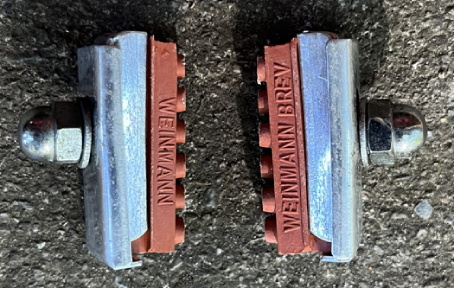
OEM Brake Shoes by Weinmann (Switzerland)
- OEM brake shoes (rubber, orange/salmon, 6-dot) were made for Schwinn by Weinmann (Switzerland). The company is no longer in business, so any NOS Weinmann shoes will be just as hard, and semi-functional as what's currently on the bike. The "Brev" mark on vintage Swiss brake shoes, such as those from the brand Weinmann, is an abbreviation for the French word "breveté," which means "patented." This indicates that the brake shoe design was covered by a patent at the time of its manufacturing.
- Pletscher (Switzerland) "Modell C" aluminum luggage rack. Had this "rat trap" style rack on a 1968 Hercules 3-speed, but the holes were a bit small for the Schwinn fender brace bolts. Could always drill out the holes to conform.
Service History
28-aug-2025 (Thursday): Took the bike to Craig at Mendon Cyclesmith to determine why the front wheel was unable to complete one full revolution before grinding to a halt. Brakes were definitely not making contact, and the wheel was correctly positioned in the forks. Perhaps the axle bearing grease dried up from sitting in storage. See solution below.
- Removed front wheel, and verified the hub spun freely, and smoothly.
- Disconnected, and removed speedometer cable from sheath, and greased cable.
- Cleaned the foam dust filter for the speedometer drive unit at front hub (see photos).
- Ultimate solution for the dragging wheel: Re-positioned the speedometer hub drive unit (Huret / France) spacer, washer, or bushing (see illustration). Someone must have replaced the hardware in the wrong order, which caused wheel to drag.
- Re-routed speedometer cable, and secured to fork with zip-tie.
- Shortened shift cable, and crimped off the end.
- Raised handle bars to the maximum height, and greased the headset, and headtube.
- Lubricated the chain.
- Total: $30.00

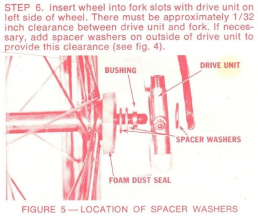
According to the instructions, "There must be approximately 1⁄32 inch clearance between drive unit and fork. If necessary, add spacer washers on outside of drive unit to provide this clearance."
Conclusion: at some point, someone must have put it back together without regard to this spacing requirement, which caused the front wheel to drag, i.e. it was unable to complete one full revolution without stopping.
Bumpy Ride
31-aug-2025 (Sunday): After riding to Chamberlain Road on the Lehigh Valley Trail (LVT) (a level, stone dust "rail to trail"), and getting back onto smooth road pavement, there was a minor, yet annoying rotational bump coming from the rear wheel. I hadn't noticed it the previous day (same path), or on the August 25 pre-purchase road test.
01-sep-2025 (Monday / Labor Day): Checked for broken spokes, but found none. Next, deflated the rear tire, and verified that the edges were seated correctly in the rim, and re-inflated to 70 lbs. psi. Guess what? No more bumping! Put one in the win column. I should have checked the pressure on day one, but the ride was smooth, and the bumping didn't start until after the second ride on the LVT. Just a fluke? Not really sure what happened. Who knows how old the tires were? The romance continues.
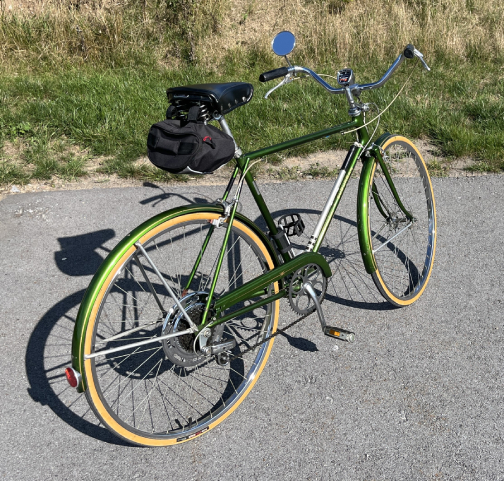
Install "New" OEM Saddle
02-sep-2025 (Tuesday): The new OEM saddle arrived. It was an eBay purchase from 27-aug-2025. The thing was in top-notch condition. Cost $44.02 with tax, and shipping. Installed, and adjusted it, and rode to Railroad Mills Road to fine tune the riding position.
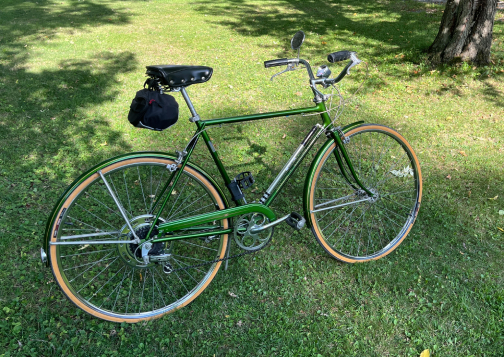
Dead Link Checker
(does not catch all types of dead links - check manually for good measure)
Links Verified MANUALLY August 28, 2025
